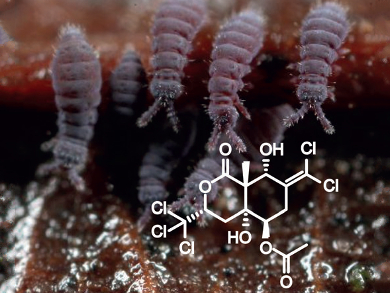Chemical Deterrent from Snow Fleas Identified
Snow fleas keep predators at bay with a chemical deterrent. German scientists have now isolated this compound and identified it by means of spectroscopic analysis and X-ray crystallography. In the journal Angewandte Chemie, they introduce this unique natural substance, a polychlorinated octohydroisocoumarin, as well as a synthetic route to produce it.
The snow flea is a species of springtail active in winter. Between December and March, these 2 mm long, dark purple creatures can be found primarily north of the Alps, on the forest floor, feeding on microorganisms even at temperatures slightly below 0 °C. In February and March, they form large, migrating colonies with millions of individuals on snow and litter.
In order to escape predators like spiders, pseudoscorpions, centipedes, and mites, they can catapult themselves several centimeters away by using the furca on their abdomen. They also have a chemical defense mechanism that ruins the predator’s appetite. Their chemical weapons are different from all of the previously known repellants.
Sigillins: A new and unique class of natural substance
Scientists from the TU Braunschweig and FU Berlin, both Germany, have now revealed the secret. In the extract from snow fleas which had been collected by Jürg Zettel, University of Bern, Switzerland, the team headed by Stefan Schulz identified an unusual molecule that they were able to isolate. By using a variety of chemical and spectroscopic methods, they were able to tease out the molecular formula and structural characteristics of the substance, which they combined to produce four different possible structures.
Comparison of computer-simulated infrared spectra with the spectrum measured for the substance allowed them to narrow the structures down to one. Based on the Latin name of the snow flea, Ceratophysella sigillata, the researchers named this compound sigillin A. The proposed structure was then confirmed by means of an X-ray crystallographic study. In an experiment that used ants as model predators, it was demonstrated that they avoided food that was treated with sigillin A after a short time.
In addition to sigillin A, the researchers found trace concentrations of eight additional closely related compounds in extract from snow fleas. These were designated sigillin B-J. The sigillins are a new and unique class of natural substance. The core of their structure is an octahydroisocoumarin, a special framework made of two six-membered rings. The compounds have four to six chlorine atoms in different structural variations. Sigillin A has a trichloromethyl carbinol group, a structure very rarely found in nature.
The researchers developed a synthetic route for the production of the structural core of the sigillins from known starting materials and established reagents.
- Sigillin A, a unique polychlorinated arthropod deterrent from the snow flea Ceratophysella sigillata,
Witali Schmidt, Thies M. Schulze, Gregor Brasse, Edyta Nagrodzka, Michael Maczka, Jürg Zettel, Peter G. Jones, Jörg Grunenberg, Monika Hilker, Ute Trauer-Kizilelma, Ute Braun, Stefan Schulz,
Angew. Chem. Int. Ed. 2015.
DOI: 10.1002/anie.201501719




